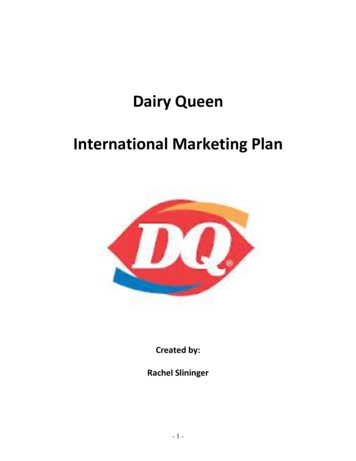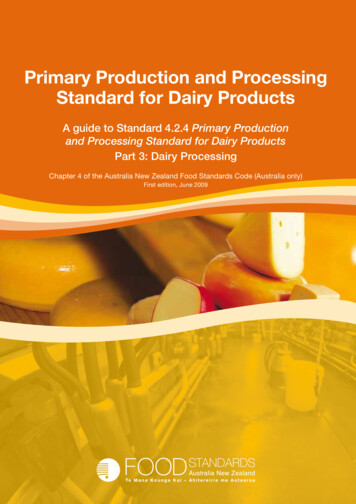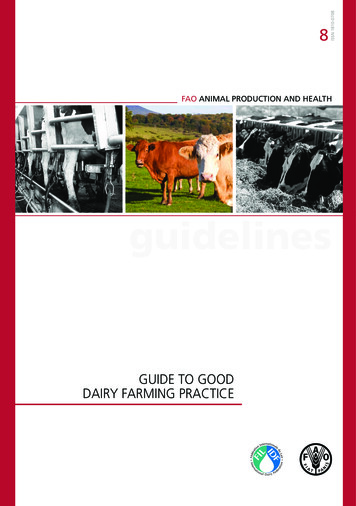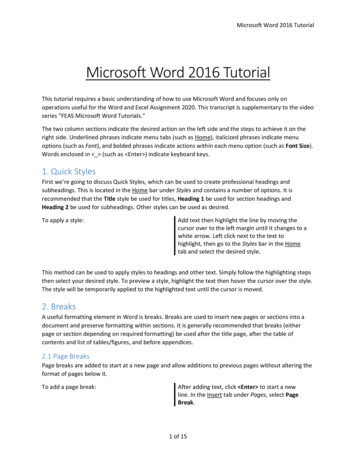
Transcription
Dairy QueenInternational Marketing PlanCreated by:Rachel Slininger-1-
IntroductionAs of today, New Zealand is the second largest ice cream consumer in the world,following the United States. Given this fact, our group has chosen to introduce DairyQueen soft serve ice cream into a market that is currently saturated with the old fashionedscoop and bucket ice cream parlors. We will assume that we are the team chosen byDairy Queen’s top management to research and analyze different strategies for theintroduction into New Zealand’s food market. Within this report, we will focus on theimportant research characteristics when entering a new market, such as country outlook,industry outlook, and the brand/product marketing strategy.Country OutlookDemographicsWhen entering New Zealand, Dairy Queen needs to evaluate all aspects of thecountry’s market in terms of population growth and age, economy, politics, legal issues,cultural, and social factors. New Zealand has very accurate information regarding itspopulation and market size. There are about 4.14 million people in New Zealand, andthat population is expected to grow by one person every 14 minutes. However, thepopulation is expected to age resulting in more of an older population. The median age isexpected to grow from 39.5 years to 43 years. Twenty one percent of the population isunder the age of 15 years old. For Dairy Queen, this means that it must market to a veryaging population.Economy and Economic TrendsNew Zealanders have an average hourly earning rate of NZ 20.04 per hour. Thisis quite comparable to earning rates in the United States. Currently the NZ is worth-2-
slightly more than the US : 1 NZ 1.36. Economic activity has been increasing,service industries have been increasing, and household consumption expenditures arealso increasing. These facts are a very good thing for Dairy Queen. With more spendingpower, the population is more open to putting their money towards more wants thanneeds. It is estimated that 16% of most household budgets are spent on food.Political and Legal EnvironmentsRecently, New Zealanders have been showing a trend towards more conservativeviewpoints. The political structure of New Zealand is a parliamentary democracy with aHead of State and Prime Minister (New Zealand Trade Centre). Their democraticstructure was modeled after the United States (New Zealand Trade Centre). They alsotend to have a high degree of political stability which will make the entrance to the NewZealand market much smoother for Dairy Queen.Another point that will help Dairy Queen is New Zealand’s import regulations.There are low tariff rates on imports and no import licensing is needed (New ZealandTrade Centre). New Zealand also has one of the most efficient and cost effectivetransportation structure in the world with shipping and air links to all parts of the world(New Zealand Trade Centre). Aside from the transportation advantages of entering NewZealand, it also has very well developed communications systems (New Zealand TradeCentre).One major factor that Dairy Queen must take into consideration is the InterimCode of Practice for ice cream (The NZ Ice Cream Industry). This code of practice mustbe followed to manage food safety. There are also some cultural and social factors thatcan be positive for Dairy Queen to enter into the New Zealand market. New Zealand-3-
consumers are known to love dairy products, but know them very well, so Dairy Queenmust have top of the line ice cream (The NZ Ice Cream Industry). New Zealanders arethe highest per capita consumers of ice cream and have more improved attitudes towardsbusiness in New Zealand. They have a very competitive and innovative ice cream marketwith high quality dairy products.Culture and Social AspectsSome social trends popping up in the area are concerns with product quality (TheMeasurement of Social Capital in New Zealand). They also respond well to price dealsbecause they monitor prices regularly. Many consumers have become more nutritionallyconscious but also like to have convenient foods (The Measurement of Social Capital inNew Zealand). Dairy Queen can really try to play on these trends by having convenientfoods and find more nutritionally sound ways to provide fast food.Industry OutlookWhen entering the ice cream industry in New Zealand, it is important to considerthe country’s prestigious dairy industry. New Zealand is known for its high quality dairyproducts which are a result of its high hygiene standards and technological processes, aswell as its optimal conditions for producing quality dairy products year-round. (NewZealand Ice Cream Industry) Considering this is an important aspect of analyzing thecurrent market situation in addition to planning the market entry.Growth Rates/Long Term ProspectsThe existing ice cream market in New Zealand looks to be a great opportunity forDairy Queen. Currently the consumption of ice cream in New Zealand is among thehighest worldwide, with its occupants consuming approximately 23 liters per year.-4-
Depending on the source, it is considered the highest consumer, or else it comes insecond behind the United States (along with Australia, these three countries lead theworld). (New Zealand Ice Cream Industry) Along with New Zealand’s heavyconsumption of ice cream, the statistics relating to growth also prove advantageous forDairy Queen when entering the market. Among the food service industry in NewZealand, ice cream parlors and vendors make up 5.9% of the annual market share andsales were NZ 254 million in 2006. (2006 Restaurant Industry Forecast) Growth isexpected to continue throughout the ice cream industry, as the rate for the past 5 yearshas been approximately 2.1% per year. (Ice Cream in New Zealand until 2011)Along with this, the food service industry in New Zealand is expected to grow byalmost 5% per year. The restaurant or food service industry has already experienced aboost and is expected to continue to grow as a result of a booming economy, the increasein immigration, and the increase in consumer’s disposable incomes. (2006 RestaurantIndustry Forecast) The foodservice market was also able to expand as a result of itsrepositioning into healthier menus, improving its selling environment, which wasnecessary to remain competitive, and a booming property market which made NewZealanders feel wealthier. (Vinita Sharma) While the outlook of the industry seemsoptimistic, there are a few challenges that may hinder the overall growth of Dairy Queenin New Zealand (Refer to Table 1 in the appendix). The inflation of energy costs, foodcosts, rent, and the growth in wages are all issues that affect the operations of a foodservice business.Because the inhabitants of New Zealand are heavy consumers of ice cream, theshops, stores, stands, etc that provide the frozen products are heavily prevalent in the-5-
culture. The majority of ice cream is sold via parlors, restaurants, and other retail scoopmethods, such as portable stands. Even though consumers in New Zealand are becomingmore health conscious, studies have shown that eating out continues to be a part of theirlifestyle, therefore the amount of ice cream eaten may not decrease; however, the kind ofice cream consumed might.Channels/DistributionEntering the market in Zealand may be seen as favorable due to the minimumnumber of barriers to trade; which include low tariffs. However, since New Zealand isprided with its ice cream manufacturing, the distribution channels are very established;possibly “locked-up.” New Zealand does not import much of its food, only 23% ascompared to the United States which imports about 45%; therefore it relies heavily on itsown production as well as Australia. New market enterers will face the challenge ofcompeting with New Zealand’s domestic components immediately when attempting toengage in the market. We will attempt to deal with this by applying our knowledge of theindustry and through the marketing plan that we intend to implement.Nature of CompetitionWhen researching the industry outlook, we looked at what Dairy Queen’scompetitors would include. There are four main ice cream companies that we feel will bein direct competition with our product. Each company contains individual strengths andweaknesses attaining to its service or products. The four we researched are Deep SouthLtd, Ginellis Company, New Zealand Natural Ice Cream, and Kiwi Stone Ice Cream.Deep South Ltd is a family owned and operated ice cream shop. It currently hasthree factories in New Zealand and manufactures a full range of retail parlor and specialty-6-
ice cream flavors in a variety of sizes. They can develop customized flavors to suitindividual customer tastes. They sell a variety of ice cream products such as cones,shakes, cakes, tin whistles, soda mixes, and many others. They have won many awardsthis year already for two best in category, including four gold and four silver medals.(Deep South Ltd.)Ginellis Company is also an award winning ice cream retailer. It is a premiumproduct portraying a very prestigious image, which can be proved by the many gold andsilver medals it has received in recent years. Ginellis also personally customizes theirproducts to fit their consumer’s wants and needs. A new flavor can be made in little timewhile not sacrificing the quality of the ice cream. One weakness that they may possess isthat they are more sophisticated and target to the upper middle to upper income classes sothey miss out on the business of most average income consumers. They also focus a lotof their business on selling to other business facilities and not as much on individualconsumers. (Ginelli’s Premium Ice Cream)New Zealand Natural Ice Cream has scooped ice cream, is constantly offeringnew flavors and improving current flavors, and has won numerous awards from the NewZealand Ice Cream Manufacturer’s Association. One of their successful marketingtactics being used is the idea of attracting customers with colorful store designs andimagery. They also have gluten free ice cream with the exception of add-inns in fourflavors. We could not determine any major weaknesses that this company faces. (NewZealand Natural Ice Cream)Kiwi Stone Ice Cream differentiates itself from many other ice cream parlors inNew Zealand by serving “smooth and creamy”, not hard packed or soft serve ice cream.-7-
It makes its ice cream fresh daily and has the unique process of mixing each personalizedice cream product on a granite stone; customizing it to every customer. A particularweakness is that they believe this is a brand new idea and claims to have a unique processof preparing the ice cream for each individual. However, they currently operate using thesame ideas and strategies as Cold Stone Creamery, which has been operating in theUnited States for over twenty years. (Kiwi Ice Cream Company Limited)Brand/Company Marketing StrategyEntry StrategyTo enter the New Zealand market, Dairy Queen must have an entry strategy thatworks well for the company. Dairy Queen’s current business plan is arranged as afranchise. A franchise is a form of licensing where the licensor makes their product orservice available to the licensee for a fee or royalty. Entering a foreign market using afranchise strategy is less capital intensive. Franchising allows for the removal of mosttrade barriers and mostly consists of small initial investments.Franchising has its downside as well. There is a lack of control for the licensor,the licensee can become a competitor of the licensor, and the licensee usually has less ofan understanding of the industry. Since franchising works so well for Dairy Queenalready, we believe they should stick with their franchising arrangement. This entrymethod removes trade barriers, reduces business risk, and decreases the initialinvestment, which increases their return on investment (ROI). Entering the market as afranchise will allow Dairy Queen to reap the advantages of the franchisee’s expertise ofthe local market.-8-
Market Coverage StrategyWe believe that Dairy Queen should start small and plan for the future. It wouldbe too great of a risk to enter New Zealand and cover the whole market. Dairy Queenwould be making a safe business move by entering only certain segments until they aresure that they can gain more market share. We believe that the best segments to targetare the urban areas such as Auckland or Christchurch. Within these areas we will findour target market, consisting of consumers that are more adaptable and open to change.Since these are larger urban areas, one advantage will be the steady inflow and traffic oftourists that want to get a ‘taste’ of New Zealand ice cream. Our target market will alsofocus more on families, social gatherings, and the recent increase of health consciousconsumers.ProductIntroducing Dairy Queen’s soft serve ice cream into a country that has adistinguished and well established dairy, as well as ice cream, industry will need to becarefully planned, and its strengths will need to be emphasized. Improving the productserved by Dairy Queen’s existing franchises is seen as necessary in order to attractconsumers. Dairy Queen’s brand image will want to portray a sophisticated anddifferentiated product in New Zealand that will be seen as a necessary ingredient inmaintaining their social image.The first step is ensuring that the ice cream served is of high quality. NewZealand prides itself on its superb dairy industry and is a large producer, as well as aconsumer, of ice cream. Also, the soft serve ice cream is not as common in the existingmarket in New Zealand in contrast to the harder scooped ice cream, and it is only served-9-
in one flavor, vanilla, compared to the multitude of flavors with scooped ice cream.Therefore, Dairy Queen should attempt to introduce multiple flavors of the soft serve.New Zealanders have a preference for a flavor called “Hokey Pokey,” which is a toffeeflavor. By offering this flavor, the consumers may be more willing to purchase ice creamin the locations it is offered.An additional factor that will differentiate Dairy Queen from its competitors willbe the availability of various flavors of ice cream cakes, as well as individual frozentreats (Refer to Figure 3 and 4 in the Appendix). Consumers will have the ability tocustomize each cake to fit individual’s special occasions or social gatherings, such as abirthdays, anniversaries, or graduation parties. Frozen treats can be grabbed for on-thego consumers or as a fun treat to children at parties, after sporting activities, or socialgatherings with friends.Another issue that the new franchise could approach is to offer low fat ice creamand frozen yogurt to cater to the rising health conscious public. Several of its competitorsare also doing the same, so as to provide another option for the public. Another issuewould be to decrease the serving sizes. The present sizes used in the United States arevery large, even for heavy consumers of ice cream, and offering smaller sizes may alsoentice the consumers who wish to eat healthier.In order to be competitive within the ice cream market, we feel that Dairy Queenwill need to put a lot of creative time and energy into the design and essence of theparlor. Current New Zealand ice cream parlors put a lot of emphasis on the design andcolor scheme; using bright and festive colors to portray how fun and exciting ice creamcan be. The structure and essence of the parlors are of the highest quality due to ice- 10 -
cream’s intense reputation in New Zealand. In the United States, Dairy Queen does notusually leave an image in the consumer’s mind of a contemporary, exciting, stylish, orpopular establishment to gather with friends and family. Many United States DairyQueen’s are currently remodeling to look more sophisticated and upbeat (Refer to Figure2 in the Appendix).The last issue with the products to be offered by Dairy Queen in New Zealandinvolves the food. The initial entry into the market is going to focus on the ice cream,however sandwiches, fries, and other assorted fast food products will be offered.Depending on the success of the food, Dairy Queen hopes to improve the volume of foodconsumed and give it a higher status in their operational strategy.ChannelsDairy Queen wishes to enter into the food industry and use a strategy similar tothe main competitors already existing. The franchise will not only operate a restaurant oractual building but also wants to open smaller locations in malls for example and otherpublic places to attract the urban crowd that are out and about in the cities. Initially itwill also try a version of a modified street vending location. Competitors offering scoopsof ice cream are currently using this method to appeal to the consumers, and since NewZealand is one of the top consumers of ice cream, having it more readily available seemsto work.PriceWhen entering Dairy Queen into New Zealand, we plan to use the same pricingstrategy that is used in the United States. Various sizes will be priced accordingly. Ourproduct will be priced below other competitors in the industry of New Zealand for one- 11 -
main reason. Since New Zealand has such a strong history in the dairy industry, we feelthat customers would be more hesitant to try new products if they were priced equally orabove that of their current producers. Therefore, in order to gain market share we thinkthat it is necessary to price our products slightly below competition.Our sizes will be relatively equal to other competitors but we plan to follow thesame price range as Dairy Queen uses in the United States. According to our research,prices will still be slightly lower than competitors, but will be high enough to maintainour brand image. We will also offer discounts or coupons upon establishment to enticeconsumers to try the new products (Refer to Figure 1 in the Appendix). Dairy Queen willprovide New Zealanders with characteristics that other ice cream parlors do not. Forinstance, Dairy Queen will have a drive thru which offers convenience, as well asproviding soft serve ice cream, rather than ice cream by the scoop. We feel that onceconsumers are aware of these aspects they may be more likely to try our product.PromotionAs far as promotion goes, we plan on the majority of our advertising being onbillboards or associated with transportation systems. Many large companies advertise onbusses, on taxis, bus stops, or even at train stations. We feel that this will be the best wayto target and attract the largest number of consumers within our target market. Themessage we want to relay through our advertising is that our product conveys a funexperience with friends or family while experiencing a taste incomparable to others.An additional advertising media that would be beneficial and necessary tocompete within the ice cream market would be television commercials. Research showsthat New Zealand is recognized as one of the top leaders in producing quality commercial- 12 -
ads. These ads are seen as an essential aspect of each competitor’s marketing plan inorder to gain ground in market share, as well as in consumer’s minds. Since Dairy Queenwill be entering into a new market, we feel that we need an advertising media that willjump out in consumer’s mind and attract them to our store over their current ice creamparlor. We will offer discounts, coupons, and promotions in order to keep currentcustomers as well as new, but only after we have our established target consumerssatisfied.As discussed in the pricing sections, we will also use coupons and discounts topromote our products. We believe that coupons will encourage first time customers to trythe product because it will be affordable. Then, we believe once they try it, they will bedrawn back to the uniqueness of soft serve, and they will become repeat customers.Sales and Market Share ProjectionsWhen Dairy Queen enters into
country’s market in terms of population growth and age, economy, politics, legal issues, cultural, and social factors. New Zealand has very accurate information regarding its population and market size. There are about 4.14 million people in New Zealand, and that population is expe











